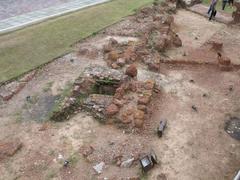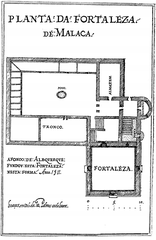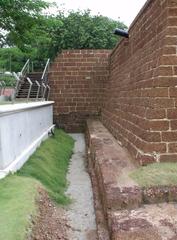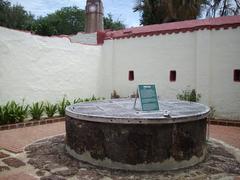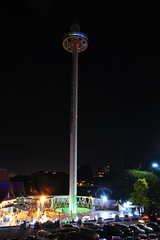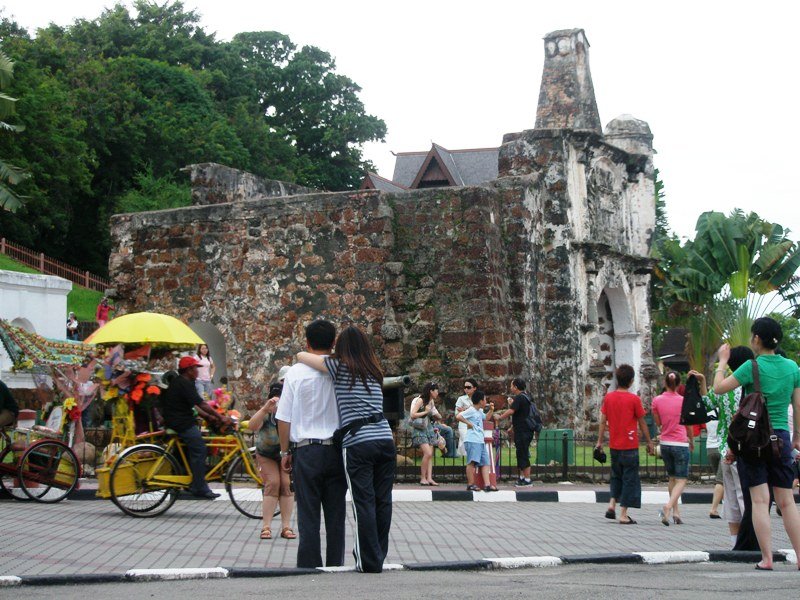
Guide to Visiting Kota A Famosa, Tanjung Kling, Malaysia
Date: 17/07/2024
Introduction
Kota A Famosa, located in Tanjung Kling, Malaysia, is a historical marvel that attracts tourists from around the globe. Constructed by the Portuguese in 1511, this fortress is one of the oldest surviving European architectural remains in Southeast Asia. The primary objective of its construction was to protect the newly conquered territory of Malacca from other European powers and local sultanates (Britannica). The fort’s strategic location at the narrowest point of the Malacca Strait allowed the Portuguese to control maritime trade routes between the Indian Ocean and the South China Sea, solidifying its importance in global trade (NST). Over the centuries, Kota A Famosa has witnessed multiple colonial powers, including the Dutch and British, each leaving their mark on its architecture and history. Today, the remnants of the fort, especially the well-preserved Porta de Santiago, stand as a testament to the region’s rich colonial heritage. This guide aims to provide a comprehensive overview of visiting Kota A Famosa, including historical insights, visitor information, and travel tips, ensuring a memorable experience for all visitors.
Table of Contents
- Introduction
- Historical Background
- Preservation and Modern Significance
- Visitor Information
- Nearby Attractions
- FAQ
- Conclusion
Exploring Kota A Famosa - Visiting Hours, Tickets, and Historical Insights in Tanjung Kling, Malaysia
Historical Background
Origins and Construction
Kota A Famosa, constructed by the Portuguese in 1511, is among the oldest surviving European architectural remains in Southeast Asia. The fortress was built under the command of Alfonso de Albuquerque following the Portuguese conquest of Malacca. The primary purpose of the fort was to defend the newly acquired territory from potential invaders, including the Dutch and the local Malay sultanates. The construction began almost immediately after the conquest, utilizing forced labor from the local population (Britannica).
Architectural Design
The original structure of Kota A Famosa was extensive, encompassing a large area with several bastions and towers. The fort was designed in a typical Portuguese style, featuring thick walls made of laterite stone and reinforced with lime mortar. The main gate, known as Porta de Santiago, is the most well-preserved part of the fort and remains a significant historical landmark today (Malaysia Traveller).
Strategic Importance
Kota A Famosa played a crucial role in the Portuguese defense strategy in the region. Its strategic location at the narrowest point of the Malacca Strait allowed the Portuguese to control maritime trade routes between the Indian Ocean and the South China Sea. The fort served as a military base, administrative center, and a hub for trade and missionary activities. The presence of the fort significantly boosted Portuguese influence in Southeast Asia, making Malacca a vital link in their global trading network (NST).
Dutch Conquest and Modifications
In 1641, the Dutch East India Company (VOC) captured Malacca from the Portuguese after a prolonged siege. The Dutch made several modifications to Kota A Famosa, including the addition of new bastions and the reinforcement of existing structures. The fort continued to serve as a defensive stronghold and administrative center under Dutch rule. The Dutch also used the fort as a base for their naval operations in the region, further solidifying their control over the Malacca Strait (Malacca.ws).
British Occupation and Partial Demolition
The British took control of Malacca in 1795 during the Napoleonic Wars, as part of a temporary arrangement with the Dutch. In 1807, the British decided to demolish Kota A Famosa to prevent it from falling into the hands of their enemies. Sir Stamford Raffles, the founder of modern Singapore, intervened and managed to save the Porta de Santiago from destruction. The rest of the fort, however, was largely dismantled, and its materials were repurposed for other construction projects in the region (The Star).
Preservation and Modern Significance
Cultural Impact
Kota A Famosa has had a lasting impact on the cultural landscape of Malacca. The fort’s presence influenced the architectural styles of subsequent buildings in the region, blending European and local elements. The site also serves as a symbol of the various colonial powers that have shaped Malacca’s history, reflecting the city’s diverse cultural heritage. The annual historical reenactments and cultural festivals held at the site further highlight its significance in the local community (Malacca.ws).
Archaeological Discoveries
Recent archaeological excavations at the site have uncovered additional remnants of the original fort, providing new insights into its construction and usage. These discoveries have helped historians and archaeologists piece together a more comprehensive understanding of Kota A Famosa’s role in the region’s history. The findings have also contributed to ongoing preservation efforts, ensuring that the site remains an important educational resource (NST).
Visitor Information
Visiting Hours and Tickets
Kota A Famosa is open to visitors daily from 9:00 AM to 6:00 PM. Tickets can be purchased on-site, with prices varying for adults, children, and seniors. It is recommended to check the official website for the latest ticket prices and any special events that might affect visiting hours.
Travel Tips
- Best Time to Visit: Early mornings and late afternoons are the best times to visit to avoid the midday heat.
- Guided Tours: Consider joining a guided tour to gain deeper insights into the history and significance of the site.
- Photography: The Porta de Santiago is a popular spot for photography, so bring your camera to capture the historical architecture.
- Accessibility: The site is accessible to visitors with mobility issues, but certain areas might be challenging to navigate.
Nearby Attractions
While visiting Kota A Famosa, consider exploring other historical sites in Tanjung Kling and Malacca, such as the Malacca Sultanate Palace Museum, St. Paul’s Hill, and the Dutch Square. These attractions offer additional context and enrich the overall historical experience.
FAQ
- What are the visiting hours for Kota A Famosa?
- Kota A Famosa is open daily from 9:00 AM to 6:00 PM.
- How much are tickets for Kota A Famosa?
- Ticket prices vary; please check the official website for the most up-to-date information.
- Are guided tours available?
- Yes, guided tours are available and recommended for a comprehensive understanding of the site.
- Is Kota A Famosa accessible for visitors with mobility issues?
- The site is generally accessible, though some areas may be difficult to navigate.
Conclusion
Kota A Famosa is more than just a historical site; it is a symbol of Malaysia’s rich and diverse heritage. The fort’s enduring presence, despite various conflicts and the passage of time, signifies the resilience and adaptability of the local population. Visiting Kota A Famosa offers a unique opportunity to delve into the colonial history that has shaped the region, from its Portuguese origins to the modifications made by the Dutch and the partial demolition by the British (The Star). The preservation efforts and archaeological discoveries continue to shed light on its historical significance, making it an invaluable educational resource (Malaysia Traveller). Whether you are a history enthusiast, a cultural explorer, or a casual tourist, Kota A Famosa offers something for everyone. Plan your visit today to experience the captivating history and cultural legacy of Tanjung Kling. Stay updated with the latest information by visiting the official website or following Kota A Famosa on social media.
References
- Malacca, 2023, Britannica britannica.com
- Heritage Site: Kota A Famosa, 2020, NST nst.com.my
- A Famosa Fortress: A Symbol of Malacca’s Colonial Past, 2019, The Star thestar.com.my
- A Famosa, 2023, Malaysia Traveller malaysia-traveller.com



